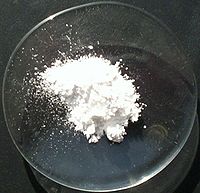
Photo from wikipedia
It is still very urgent and challenging to simultaneously develop high‐rate and long‐cycle oxide cathodes for sodium‐ion batteries (SIBs) because of the sluggish kinetics and complex multiphase evolution during cycling.… Click to show full abstract
It is still very urgent and challenging to simultaneously develop high‐rate and long‐cycle oxide cathodes for sodium‐ion batteries (SIBs) because of the sluggish kinetics and complex multiphase evolution during cycling. Here, the concept of accurately manipulating structural evolution and formulating high‐performance heterostructured biphasic layered oxide cathodes by local chemistry and orbital hybridization modulation is reported. The P2‐structure stoichiometric composition of the cathode material shows a layered P2‐ and O3‐type heterostructure that is explicitly evidenced by various macroscale and atomic‐scale techniques. Surprisingly, the heterostructured cathode displays excellent rate performance, remarkable cycling stability (capacity retention of 82.16% after 600 cycles at 2 C), and outstanding compatibility with hard carbon anode because of the integrated advantages of intergrowth structure and local environment regulation. Meanwhile, the formation process from precursors during calcination and the highly reversible dynamic structural evolution during the Na+ intercalation/deintercalation process are clearly articulated by a series of in situ characterization techniques. Also, the intrinsic structural properties and corresponding electrochemical behavior are further elucidated by the density of states and electron localization function of density functional theory calculations. Overall, this strategy, which finely tunes the local chemistry and orbitals hybridization for high‐performance SIBs, will open up a new field for other materials.
Journal Title: Advanced Materials
Year Published: 2022
Link to full text (if available)
Share on Social Media: Sign Up to like & get
recommendations!